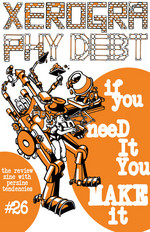FIVE QUESTIONS WITH XEROGRAPHY DEBT EDITOR DAVIDA GYPSY BREIER!

Xerography Debt, now in its 26th issue, is an in-depth, passion-first, all-inclusive review zine for zinesters, about zinesters, by zinesters. We recently got in touch with Xerox Debt editor Davida Gypsy Breier and asked her to talk zines, journalism, and zombies.
Q: As someone currently putting out one of the only zine reviewing publications that hasn’t fled for the blogs/’net, I think you’re a pretty good person to ask this: Is print dead or dying? If so, what can we do to shock it back to life?
A: Personally, I am less concerned with print “dying” and more concerned with independent voices and how those voices are discovered and connect. Waves of technology have affected independent publishers from the very beginning. In many respects modern paper zines exist because of inexpensive photocopy technologies. The proliferation of zines in the ’90s also coincided with PCs gaining popularity and desktop publishing becoming available to the masses. In the pre-‘net era we relied on postal mail and reading about zines in other zines. It kept people and ideas rather underground, for better or worse. Now a three-second search could turn up hundreds of zines and I can get immediate recommendations from contacts online. Blogs and the internet could actually help zines, but zine publishers need to stop seeing it as an either or proposition. I have two active paper zines, two blogs, and a website. Each has its own purpose and the online components support the paper.
I think that paper zines are something tangible and there is no way a digital replica can replace all the chaos contained in the average zine.
Q: What was the first zine you read? What kind of impression did it make on you? What about the last zine?
A friend gave me a copy of Reptiles of the Mind (and also Factsheet 5). RotM was a perzine written by a young woman in Tennessee. It gave me the idea that I could create a zine. She included reviews in the back of her zine and I sent away for copies. Within a few months I was doing a zine and one of those people I first wrote to is still among my closest friends. That was in 1994.
I think the last one I read was The Ken Chronicles #13, by a retired auto industry worker.

Q: How do you feel about the future of zines?
I fear that zines may become a lost art among the younger generations. They have never known anything other than the internet and often that is the go-to source for knowledge instead of considering a book or zine. If that is the case, I think that zines will need to be more than just paper and ink to survive long-term. I am all too familiar with similar issues facing mainstream publishing, but in many cases zines are more apt to survive because they can adapt. I think that a lot of the piss and vinegar of self-publishing has migrated to the ‘net and that zines really need an infusion of that. I see very few outraged or political zines these days.
Q: As someone who reviews zines, do you consider yourself a journalist? Do you think journalism gives much thought to zines as a modern, relevant, culture?
I think I am more an accidental historian than journalist. I don’t think journalism thinks zines are any more relevant than zines think journalism is relevant.
Q: What kind of projects do you have coming up?
I am currently working on Rigor Mortis #3, a horror zine I started in 2008. Zombies are usually the main focus, but we are branching out into other genres. Xerography Debt #27 should be out in the summer and we are working on that now. I also contributed to a book, Ninety-Five: Meeting America’s Farmed Animals in Stories and Photographs, that will be out in June. I was able to visit animal sanctuaries in three states and take portraits of the animals there. All three projects are keeping me very busy at the moment.
(Davida Gypsy Beier photo by Uli Loskot)